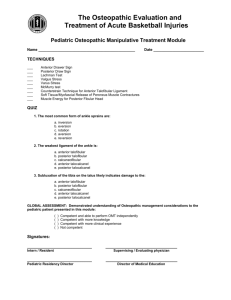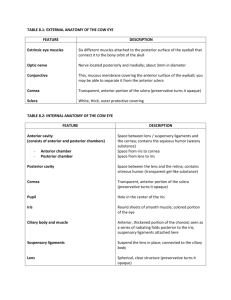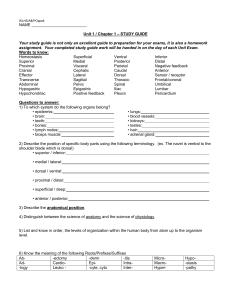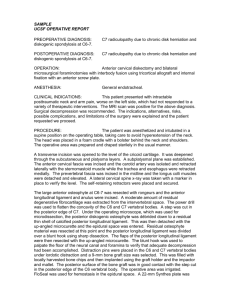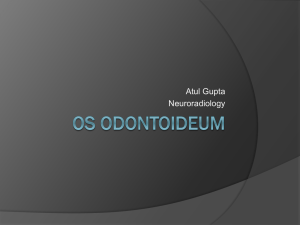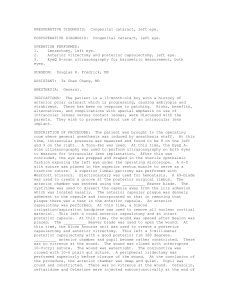Monogenea (Capsaloidea) from Philippine Marine Fishes
advertisement
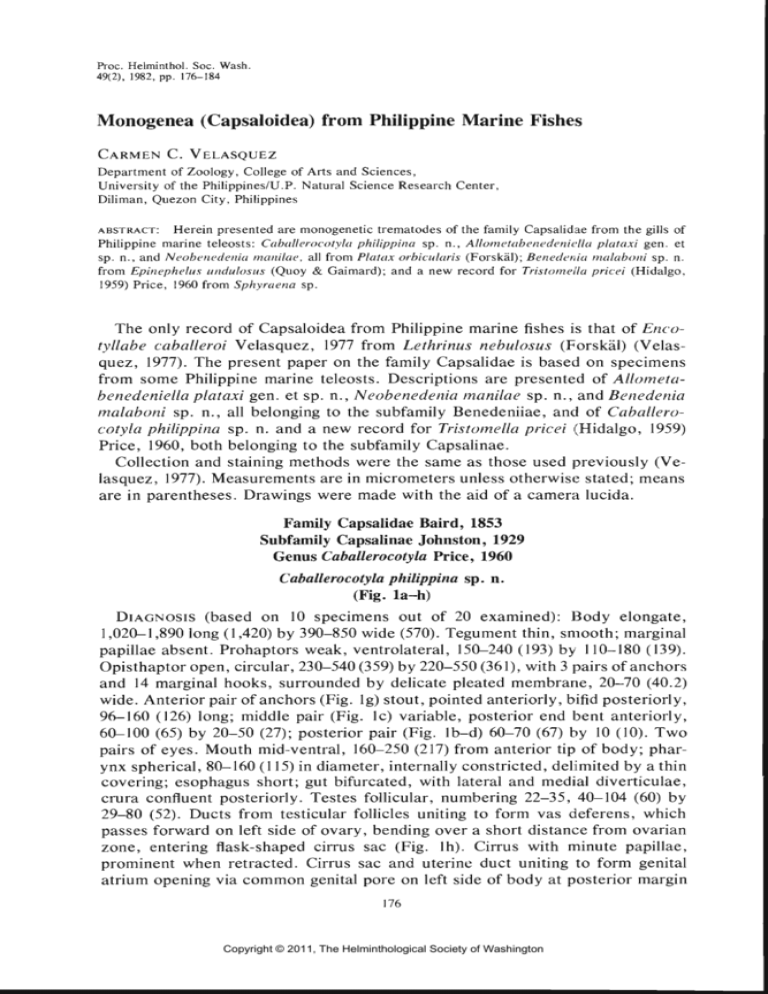
Proc. Helminthol. Soc. Wash. 49(2), 1982, pp. 176-184 Monogenea (Capsaloidea) from Philippine Marine Fishes CARMEN C. VELASQUEZ Department of Zoology, College of Arts and Sciences, University of the Philippines/U.P. Natural Science Research Center, Diliman, Quezon City, Philippines ABSTRACT: Herein presented are monogenetic trematodes of the family Capsalidae from the gills of Philippine marine teleosts: Caballerocotyla philippina sp. n., Allometabenedeniella plataxi gen. et sp. n., and Neobenedenia manilae, all from Platax orbicularis (Forskal); Benedenia malaboni sp. n. from Epinephelus undulosus (Quoy & Gaimard); and a new record for Tristomeila pricei (Hidalgo, 1959) Price, 1960 from Sphyraena sp. The only record of Capsaloidea from Philippine marine fishes is that of Encotyllabe caballeroi Velasquez, 1977 from Lethrinus nebulosus (Forskal) (Velasquez, 1977). The present paper on the family Capsalidae is based on specimens from some Philippine marine teleosts. Descriptions are presented of Allometabenedeniella plataxi gen. et sp. n., Neobenedenia manilae sp. n., and Benedenia malaboni sp. n., all belonging to the subfamily Benedeniiae, and of Caballerocotyla philippina sp. n. and a new record for Tristomeila pricei (Hidalgo, 1959) Price, 1960, both belonging to the subfamily Capsalinae. Collection and staining methods were the same as those used previously (Velasquez, 1977). Measurements are in micrometers unless otherwise stated; means are in parentheses. Drawings were made with the aid of a camera lucida. Family Capsalidae Baird, 1853 Subfamily Capsalinae Johnston, 1929 Genus Caballerocotyla Price, 1960 Caballerocotyla philippina sp. n. (Fig. la-h) DIAGNOSIS (based on 10 specimens out of 20 examined): Body elongate, 1,020-1,890 long (1,420) by 390-850 wide (570). Tegument thin, smooth; marginal papillae absent. Prohaptors weak, ventrolateral, 150-240 (193) by 110-180 (139). Opisthaptor open, circular, 230-540 (359) by 220-550 (361), with 3 pairs of anchors and 14 marginal hooks, surrounded by delicate pleated membrane, 20-70 (40.2) wide. Anterior pair of anchors (Fig. Ig) stout, pointed anteriorly, bifid posteriorly, 96-160 (126) long; middle pair (Fig. Ic) variable, posterior end bent anteriorly, 60-100 (65) by 20-50 (27); posterior pair (Fig. Ib-d) 60-70 (67) by 10 (10). Two pairs of eyes. Mouth mid-ventral, 160-250 (217) from anterior tip of body; pharynx spherical, 80-160 (115) in diameter, internally constricted, delimited by a thin covering; esophagus short; gut bifurcated, with lateral and medial diverticulae, crura confluent posteriorly. Testes follicular, numbering 22-35, 40-104 (60) by 29-80 (52). Ducts from testicular follicles uniting to form vas deferens, which passes forward on left side of ovary, bending over a short distance from ovarian zone, entering flask-shaped cirrus sac (Fig. Ih). Cirrus with minute papillae, prominent when retracted. Cirrus sac and uterine duct uniting to form genital atrium opening via common genital pore on left side of body at posterior margin 176 Copyright © 2011, The Helminthological Society of Washington OF WASHINGTON, VOLUME 49, NUMBER 2, JULY 1982 • 177 of prohaptor. Ovary smooth, 50-130 (88) by 50-150 (103), median, immediately pretesticular. Oviduct short, extending to left and entering ootype immediately anterior to vitelline reservoir; vagina short, opening to left margin of body at level of intestinal crura. Vitellaria occupying greater part of body, extending to cephalic lobe. Egg elongate, broadly filamented at both ends, 20 by 12. HOST: Platax orbicularis (Forskal). LOCATION: Gills. LOCALITY: Malabon, Rizal, Luzon Island, Philippines. HOLOTYPE: USNM Helm. Coll. No. 76331. PARATYPES: C. C. Velasquez Coll. No. 538 (2)b. Remarks Price (1960) proposed the genus Caballerocotyla, characterized by the open central haptoral area and testes confined to the inter-intestinal field. Although Yamaguti (1963) relegated it to subgeneric rank, I agree with Stunkard (1962) in accepting Price's (1960) proposal, with the type species Caballerocotyla biparasitica (Goto, 1894). Stunkard (1962) presented a new key to the species and recognized C. caballeroi (Winter, 1955) on the gills of Sarda orientalis; C. magronum (Ishii, 1936) on the gills of Thy units orientalis (synonym of Thunnus thynnus); C. manteri (Price, 1951) on the gills of Euthynnus alleteratus; C. gouri (Chauhan, 1952) on the operculum of Thynnus thunnina (synonym of Euthynnus yaito}; C. pelamydis on the gills of Sarda sarda; C. katsuwoni (Ishii, 1936) on the gills of Katsuwonus vagans; C. foliacea (Goto, 1894) on the gills of an undetermined Japanese fish; and C. klawei Stunkard, 1962 from the nasal capsule of Neothunnus macropterus. This is the first representative of Caballerocotyla to be described from a marine teleost in the Philippines. It differs from all known species by the shape and size of prohaptor, opisthaptor, and opisthaptoral hooks, the size and number of testes, character and size of the egg, and host. Subfamily Benedeniinae Johnston, 1931 Allometabenedeniella plataxi gen. et sp. n. (Fig. 2a^c) DIAGNOSIS (based on 10 out of 27 examined): Body subtriangular, 640-1,350 (1,200) long including opisthaptor, maximum width 370-1,200 (990) at posterior % of body proper. Prohaptor a pair of oval ventrolateral suckers, 64-210 (147) by 88-220 (178); anteroventrally separated by a distance of 40-200 (114) and ventrally by 40-80 (43). Opisthaptor muscular, 220-680 (390) by 270-680 (480), with narrow frilled membrane without marginal hooklets; 3 pairs of anchors, anterior pair (Fig. 2a) wedge-shaped, bifid, 40-150 (59) by 4-32 (16), pointed at free anterior end; middle anchors (Fig. 2c) slender, needlelike, 40-90 (65) by 4-16 (9), overlapping posterior, very slender, pointed anchors, 24-80 (40) by 4-8 (4) (Fig. 2b). Two pairs of eye spots, anterior smaller than posterior; mouth oval, 20-80 (63) wide, opening immediately between posterior pair of eye spots; pharynx 48-140 (94) by 72-210 (156), notched on each side anterodorsally. Crura numerous, branched laterally and medially, branches dendritic, not confluent posteriorly. Testes oval, immediately postequatorial, juxtaposed, right one 80-144 Copyright © 2011, The Helminthological Society of Washington 178 • PROCEEDINGS OF THE HELMINTHOLOGICAL SOCIETY (113) by 80-176 (129), left one 80-144 (91) by 48-168 (124). Vas deferens sinuous, ascending along sinistrodorsal side of ovary, turning to right, and joining muscular ejaculatory duct, on its course to cirrus. Cirrus pouch thin, muscular, conspicuously globular, occupying a space 96-232 (191) by 80-208 (108) enclosing a circularly winding sclerotized eversible cirrus; distal end of cirrus with tiny openings. Prostatic reservoir filled with fine granules between ovary and right crus. Ovary ovoid, 40-144 (98) by 24-180 (122), in the middle half of body proper. Germiduct arising from dorsal side of ovary, joining vitelline duel: from vitelline reservoir, turning forward anterodextral to ovary, receiving short duct from spherical seminal receptacle; ootype and winding uterine duct surrounded by shell-gland cells containing oculate developing embryos. Uterus proper expanded anteriorly, 80-168 (135) long by 9.6-64 (34) wide, sclerotized, running obliquely forward across left crus and opening dorsally on left margin of body at level of pharynx. In each of 2 specimens, in the expanded uterus proper was found a single dark yellow polyhedral egg 104-112 (108) by 40 at anterior end and 88-96 (92) at posterior end with short twirled filament. Uterus proper opening posterolateral to pharynx. Vagina tubular on left margin of body; vaginal duct short, narrow, winding. Vitellaria coextensive with intestine and its branches; vitelline reservoir anterolateral to ovary, receiving vitelline ducts from lateral sides; vitelline ducts joining germiduct from dorsal side of vitelline reservoir. Parasite of marine teleosts. HOST: Platax orbicularis (Forskal). LOCATION: Gills. LOCALITY: Manila Bay, Luzon Island. HOLOTYPE: USNM Helm. Coll. No. 76332. PARATYPES: C. C. Velasquez Coll. No. 538 (2)b2. Remarks Allometabenedeniella plataxi sp. n. is the type and only species of the new genus Allometabenedeniella. It differs from the most closely related Metabenedeniella hoplognathi (Yamaguti, 1942) essentially in the following respects: (1) shape and size of body; (2) anchor sizes and shapes; (3) unusual shape of the cirrus pouch; (4) circularly winding, long, eversible, sclerotized cirrus; and (5) uterus enclosed in a thin-walled sac, characteristically expanded anteriorly. Allometabenedeniella gen. n. GENERIC DIAGNOSIS—CAPSALIDAE, BENEDENIINAE: Oculate. Prohaptor suckerlike. Opisthaptor with frilled marginal membrane, marginal hooks missing. Three pairs of anchors; anterior pair wedge-shaped, bifid at posterior end, others needlelike. Pharynx notched. Crura with numerous side branches not united posteriorly. Figures 1-4. Whole-mount drawings are ventral view, except Figure 1, which is dorsal view. 1. Caballerocotyla philippina sp. n. a, eggs; b and g, anterior anchors; c and d, middle anchors; e and f, posterior anchors; h, cirrus sac. 2. Allometabenedeniella plataxi gen. et sp. n. a, anterior anchor; b, posterior anchor; c, middle anchor. 3. Neobenedenia manilae sp. n. a, egg; b, anterior anchor; c, posterior anchor; d, middle anchor. 4. Benedenia malaboni sp. n. a and b, anterior anchors; c and e, middle anchors; d and f, posterior anchors. Copyright © 2011, The Helminthological Society of Washington OF WASHINGTON, VOLUME 49, NUMBER 2, JULY 1982 Copyright © 2011, The Helminthological Society of Washington 179 180 • PROCEEDINGS OF THE HELMINTHOLOGICAL SOCIETY Testes juxtaposed, postequatorial. Vas deferens winding anteriorly, then posteriorly, entering into muscular ejaculatory duct, thence to a prominent circularly winding, long, eversible, sclerotized cirrus. Prostatic reservoir between ovary and right crus. Prostatic bulb elongate, thick-walled, muscular, with its distal end entering into globular cirrus pouch, enclosing the circularly winding, sclerotized cirrus. Ovary subspherical, equatorial, just anterior to left testis. Uterus enclosed in a wide, thin-walled sac, surrounded by shell-gland cells; anteriorly expanded, sclerotized, opening dorsolateral to genital pore. Eggs polyhedral, with twirled filament at posterior end. Vagina tubular, elongate, opening adjacent to uterine pore. Vitellaria coextensive with intestine and its branches; vitelline reservoir well developed immediately anterior to ovary. Parasitic on gills of marine teleosts. GENOTYPE: Allometabenedeniella plataxi sp. n. Genus Neobenedenia Yamaguti, 1963 Neobenedenia manilae sp. n. (Fig. 3a-d) DIAGNOSIS (based on 6 out of 10 examined): With characters of the genus. Oculate. Body elongate, 1,050-1,940 by 500-1,060 (688) maximum width. Prohaptor elliptical, weak, 180-270 (210) by 130-170 (150), concentric surface markings distinct. Opisthaptor circular, not indented, 200-320 (280) by 250-380 (310), marginal membrane relatively wide, 20-40 (35). Marginal hooklets; present. Anterior pair of haptoral hooks 70-90 (76) by 20, pointed at anterior end, 10 long, curved, posterior end truncated, slightly bifid; middle pair of hooks fairly stout, 70-85 (75) by 10; posterior pair of hooks very small, pointed at anterior end, V?Vio of middle pair. Mouth midventral, posterior to prohaptor; muscular pharynx 50-120 (80) by 100-220 (140). Esophagus short, intestinal crura dendritic, extending to posterior extremity of body. Testes equatorial, smooth, oval, right one 100-240 (110) by 80-200 (120); left one 130-250 (180) by 100-200 (130). Vas deferens coiling anteriorly from testes, intercecal, curving right to cirrus pouch, 150-380 (260) by 40-50 (45), enclosing muscular prostatic reservoir, 70-150 (120) by 50-70 (60); seminal vesicle continuing as ejaculatory duct; prostatic glands linearly aligned into 2 lateral symmetrical groups. Genital atrium submedian. Glands of Goto minute, posttesticular. Ovary median, pretesticular, 50-130 (80) by 60-110 (90); seminal receptacle 50-100 (80) by 50-100 (80) in 1 specimen. Vitellaria follicular, extending from oral sucker to posterior end of body. Vitelline ducts uniting medially to form a transverse reservoir just anterior to ovary. Vagina absent. Single egg collapsed, 107 by 33 (Fig. 3a), with short, curved, stout appendages at one end and slender at opposite end. In 1 dorsoventrally flattened immature egg, wider end with 1 long filament and 2 lateral, short, blunt, marginal processes. HOST: Platax orbicularis (Forskal). LOCATION: Gills. LOCALITY: Manila Bay, Luzon Island. HOLOTYPE: USNM Helm. Coll. No. 76333. PARATYPES: C. C. Velasquez Coll. No. 560 (l)b. Copyright © 2011, The Helminthological Society of Washington OF WASHINGTON, VOLUME 49, NUMBER 2, JULY 1982 • 181 Remarks Neobenedenia manilae sp. n. differs from the most closely related species, N. muelleri (Meserve, 1938) Yamaguti, 1963 and N. longiprostata Bravo-Hollis, 1971, in (1) size of body, (2) anchor sizes and shapes, (3) character of the cirrus complex, (4) distribution of the prostatic glands, and (5) host. Genus Benedenia Diesing, 1858 Benedenia malaboni sp. n. DIAGNOSIS (based on 3): With characters of the genus. Oculate. Body elliptical, 990-1,470 (1,270) long by 465-675 (560) wide. Tegument fairly thick, smooth. Prohaptors suckerlike, 135-180 long (150), 120-195 (160) wide. Opisthaptor almost globular, 300^50 (350) long, 255-360 (300) wide, aseptate, surrounded by a thin, pleated, marginal membrane, 30 wide, with 3 pairs of anchors in linear series and 14 marginal hooklets. Anterior pair stout, 60-90 (75) long, 15 maximum width in holotype; right anchor pointed anteriorly (Fig. 4a), left one sinuous, recurved, slender anterior end (Fig. 4b); in the paratypes, shape of anchors as in left one; middle pair 45-77 (65) by 3, posterior end recurved, slightly bifid (Fig. 4c, e); posterior pair !/3 length of middle pair, sinuous, irregular, with sharp, recurved posterior pointed end (Fig. 4d, f). Mouth midventral at level of posterior margin of prohaptors, continuing to pharynx, 120-150 (135) by 90-180 (135). Gut bifurcated, branching medially and laterally, not confluent posteriorly. Two testes side by side, equatorial, smooth, oval, 135-180 (165) by 90-135 (114); vasa efferentia anastomosing to form sinuous vas deferens, paralleling left intestinal crus on its course to cirrus. Cirrus complex consisting of cirrus, prostatic reservoir, seminal vesicle in cirrus pouch. Cirrus 75 long, 30 wide; prostatic reservoir 45-60 (54), 38-45 (42) wide. Prostatic gland cells prominent, posterior to prostatic reservoir. Glands of Goto not distinct. Common genital pore submarginal on left near anterior level of pharynx, immediately at posterior margin of prohaptor. Ovary protesticular, oval, 60-105 (81) long, 60-90 (75) in diameter; oviduct receiving duct from vitelline reservoir proceeding anteriorly to ootype. Ootype wide, surrounded by Mehlis" gland cells; uterus fairly short, opening into genital atrium. Vitellaria follicular, occupying almost entire available space of body proper. Vitelline reservoir anterosinistral to ovary. Egg filamented, 150 long, 120 maximum width. Unknown organ of Yamaguti (1934), 45-60 (50) by 38-45 (43). Vagina narrow, opening at left margin near genital atrium. HOST: Epinephelus undulosus (Quoy and Gaimard). LOCATION: Gills. LOCALITY: Dagatdagatan, Malabon, Rizal, Luzon Island. HOLOTYPE: USNM Helm. Coll. No. 76334. PARATYPES: C. C. Velasquez Coll. No. 438d3. Remarks Benedenia malaboni sp. n. is apparently closely related to either B. sebastodis (Yamaguti, 1934) Meserve, 1938 ovB. epinepheli (Yamaguti, 1937) Meserve, 1938; however, it differs from both in the (1) sizes and shapes of the prohaptors and Copyright © 2011, The Helminthological Society of Washington 182 • PROCEEDINGS OF THE HELMINTHOLOGICAL SOCIETY opisthaptor, (2) sizes and shapes of the haptoral hooks, (3) character of the cirrus prostatic reservoir complex, and (4) size of egg. Capsalinae Johnston, 1929 Tristomella pricei (Hidalgo, 1959) Price, 1960 (Fig. 5a-h) REDESCRIPTION (based on 1 specimen): Body almost circular, 7,560 long by 6,370 wide; dorsal surface slightly convex with 2 rows of spines at lateral margins, an inner row of 14-18 spines on each side, 60 by 30, with 3-4 cuspids, and an outer row of about 63-100 spines on each side, 42 by 18, with 1-4 cuspids (Fig. 4d-h). Prohaptors circular, disklike, 1,320 by 1,320. Opisthaptor saucer-shaped, 3,500 by 3,200, surrounded by a delicate pleated membrane; central heptagonal area open, with 7 rays radiating from it; ventral surface papillate. Opisthaptoral anchors lancet-shaped, almost straight, left partly cut, 434 by 79, right 579 by 105. Marginal hooklets present. Oral aperture median, 158 by 395 Pharynx constricted; digestive tract as in type. General aperture at level of constriction of pharynx and at distal margin of left prohaptor. Cirrus pouch pestle-shaped, 1,850 long, 263 maximum width. Cirrus with numerous pulvinate elevations. Testes numerous, interintestinal, partly extraintestinal within extralateral limits of longitudinal nerves. Ovary lobate, 1,000 by 1,250. Vitelline follicles extensive as in type. Vagina narrow, opening posterior to and adjacent to genital aperture. Ootype posterior to cirrus pouch. No egg. HOST: Sphyraena sp. LOCATION: Gills. LOCALITY: Visayan Islands, Philippines. SPECIMEN: USNM Helm. Coll. No. 76336. Remarks This single specimen from Sphyraena sp. was given to the author by Mrs. Lolita Santos Basio of the Manila Medical Center. It appears smaller than those described by Hidalgo (1959) from Makaira mitzukurii (Jordan and Snyder) and Price (1960) from Makaira marlina Jordan and Evermann. The host may have been misidentified. Acknowledgments This work was supported in part by grant AI 02575-05 from the National Institute of Allergy and Infectious Diseases, U.S. Public Health Service, with the cooperation of the Smithsonian Institution, Washington, D.C., % Dr. I. E. Wallen and a grant-in-aid from the National Research Council of the Philippines, I.E. Project 53. Thanks are due to Dr. J. Ralph Lichtenfels, Animal Parasitology Institute, Agricultural Research Service, U.S.D.A., for space facilities and loan of type specimens, and to Mr. D. E. Zwerner for furnishing a microfiche copy of Figure 5. surface. Tristomella pricei (Hidalgo, 1959) Price, 1960. a, anchor; b-h, body spines on dorsal Copyright © 2011, The Helminthological Society of Washington OF WASHINGTON, VOLUME 49, NUMBER 2, JULY 1982 Copyright © 2011, The Helminthological Society of Washington 183 184 • rKuut,t,uiMus ur ii-it, J-HILMUNII-IULUUI^AL the world bibliography on monogenetic trematodes. The U.P. Natural Science Research Center, Diliman, Quezon City, provided space facilities. Literature Cited Hidalgo, E. E. 1959. Hallazgo de una nueva especie de Capsala. Capsala price! n. sp. (Trematoda, Monogenea) en un pes marino del puerto de Mazatlan. Sinaloa, Mexico. An. Inst. Bioi. 29(1-2):209-217. Price, Emmett W. 1960. The giant marlin, Makaira marlina Jordan and Evermann, a new host of Capsala pried Hidalgo, 1959, with a review of the subfamily Capsalinae. In Libro Homenaje al Doctor Eduardo Caballero y Caballero, pp. 237-244. Stunkard, Horace W. 1962. Caballerocotyla klawei sp. n., a monogenetic trematode from the nasal capsule of Neothunnus macropterus. 3. Parasitol. 48:883-890. Velasquez, Carmen C. 1977. A new monogenetic trematode, Encotyllabe caballeroi sp. n. (Capsalidae) in a marine fish from the Philippines. Sobretiro de excerta parasitologica en memoria del Doctor Eduardo Caballero y Caballero. Inst. Biol. Publ. Especiales, pp. 117-120. Yamaguti, S. 1934. Studies on the helminth fauna of Japan. Part 2. Trematodes of Fishes, I, pp. 253-541. Yamaguti, S. 1963. Systema Helminthum. Vol. IV. Monogenea and Aspidocotylea. Interscience Publ. 699 pp. Survey or Taxonomic Papers Authors submitting manuscripts of a survey or taxonomic nature for publication in the Proceedings of the Helminthological Society of Washington are urged to deposit representative specimens in a recognized depository such as the National Parasite Collection at Beltsville, Maryland and include the accession numbers in the manuscript. Copyright © 2011, The Helminthological Society of Washington


